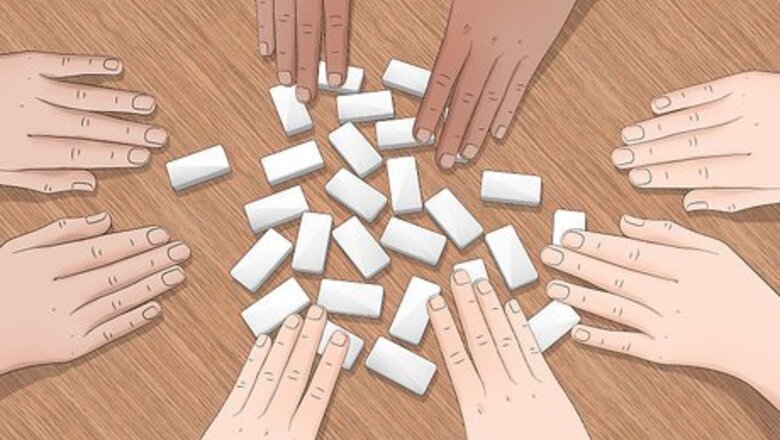
views
Playing Straight Dominoes

Play the game with 2 to 4 players. If there are 4 players, you could choose to play as partners with the person sitting opposite you, or you can each play your own hands. If you want to play with more than 4 people, use a double-12 set instead of a double-9 set. A double-12 set comes with 91 tiles, and a double-9 set comes with 55 tiles. If you need to buy a dominoes set, you can find one here.

Shuffle the dominoes face down and draw to see who plays first. Lay all the tiles face down on a flat surface in front of you. Have one player mix up the tiles so that they are thoroughly shuffled. Let each person draw one tile—the person with the highest double will go first. If a double wasn't drawn, the person with the heaviest tile (the tile with the most pips) will go first. Put the tiles back into the pile and give them another quick shuffle. Fun Fact: Every dot on a tile is an individual “pip.” Because each game of dominoes involves playing several hands, trade off who shuffles at the beginning of each hand so everyone gets a turn.

Have each player draw 7 dominoes for their hand. You can pick from anywhere in the pile, but after a tile has been picked, it can't be put back into the pile. Set your 7 dominoes up in front of you so that you can see them, but try to keep them hidden from your neighbors. Play on a hard surface if you can, as that will make it easier to stand the dominoes on edge in front of you.
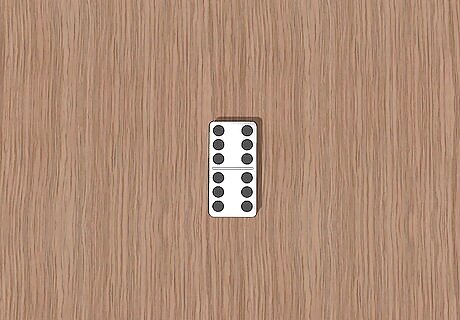
Place the first tile in the center of the table to begin the round. The person who drew the tile to go first can put down whatever tile they want to get the game started. If this is you, it's generally a good idea to lay down a tile that you know you'd be able to build off of in your next turn. For example, if you lay down a tile with 3 pips on one side and 1 pip on the other but don't have any other tiles with 3 or 1 pips on a side, you wouldn't be able to take a turn unless someone else lays down a tile you can match.
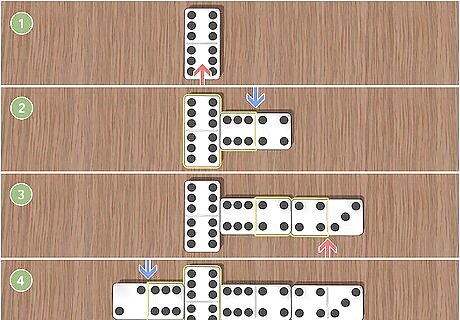
Take turns building off the tiles on the board with the tiles in your hand. Go counter-clockwise around the table. Each turn consists of a player laying down one tile. That tile has to have a side that matches the open end of a domino that is already on the table. Continue taking turns until someone uses up all of their tiles. If you lay down a tile with a blank side, it can only be matched with another tile that also has a blank side. In some games, people choose to make the blanks “wild,” meaning you can ascribe any value to it. You can choose whichever option you like best!Tip: If you start to run out of room on the table, you can lay down subsequent dominoes so that the line changes direction.
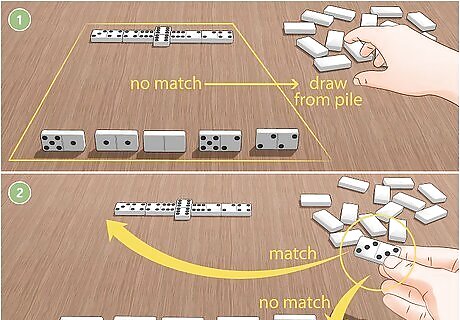
Pick up a tile from the draw pile if you can't play a tile in your hand. If the tile you pick up from the draw pile matches something on the board, you can play it. If not, add the tile to your hand. The turn then passes to the next person. In this way, you can end up with way more than 7 tiles in your hand during any given game.

Win the round by using all of the dominoes in your hand. Whoever is the first person to lay down all the tiles from their hand onto the table is the winner of that round. There will be at least 7 turns per round, but if everyone ends up having to pick up extra tiles from the draw pile, the game could last much longer than that. Though you may have won the round, that doesn't mean you've won the game! You'll have several hands to play before the entire game is finished.
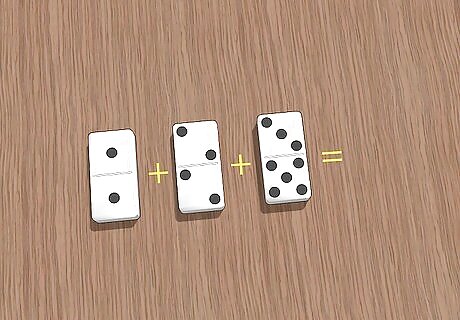
Tally the score by adding up the points left in each player's hand. Have each player add up the total number of pips on the tiles they have left in front of them. On a piece of paper, add those numbers to the column of the person who won that hand. The first person to get to 100 points wins the game. Because you have to get to 100 points before the game ends, there are multiple chances for every player to win rounds and ultimately come out victorious at the end!
Competing at Mexican Train Dominoes
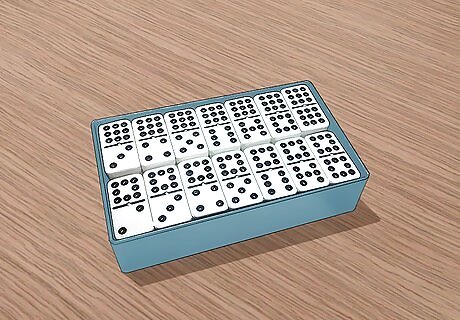
Pull out the double-12 or double-9 domino from the set. Choose a domino set with a double-12 for a 13-hand game; choose the double-9 set for a 10-hand game. From whichever set you choose, remove the highest double-sided tile before you move on to shuffling. In Mexican Train, the game starts with the highest double-sided tile in the middle of the table. Each hand after that starts with the double-sided tile that is one number less than the one preceding it: the first hand starts with the double-12, the second hand starts with the double-11, the third hand starts with the double-10, and so on.

Shuffle the remaining dominoes facedown on the table in front of you. Lay out all of the tiles and flip them so they are pip-side down. Thoroughly mix them up by hand. Because there are so many rounds played in Mexican Train, have players take turns flipping and shuffling the tiles.

Have each player draw their tiles from the shuffled tiles. After you draw your tiles, set them up in front of you on their sides so you can see what you have, but try your best to keep them hidden from your neighbors. You can play Mexican train with up to 8 people if you have a double-12 set. If you have a double-9 set, you can play with only 2 to 4 people. Follow this breakdown to determine how many tiles each person should take: Double-12: 2 to 3 players take 16 tiles each; 4 players take 15 tiles each; 5 players take 14 tiles each; 6 players take 12 tiles each; 7 players take 10 tiles each; 8 players take 9 tiles each. Double-9: 2 players take 15 tiles each; 3 players take 13 tiles each; 4 players take 10 tiles each.

Put the remaining tiles into the “train yard” to draw from on future turns. If on any given turn you don't have a domino in your hand that can be played on either the Mexican train or your personal train, draw one tile from the train yard. If that tile can be played, play it. If not, it gets added to your hand and the turn passes on to the next player. The “train yard” is also sometimes called the “bone pile.” Keep the tiles in the train yard face down.
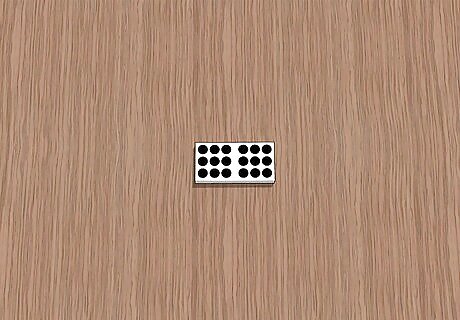
Set the double domino in the center of the table to begin play. After drawing tiles for your hand and creating the train yard, it's finally time for gameplay to begin! There are sets you can buy that include a little stand for the starter tile, which you're welcome to use if you have it. If not, simply place the double-12 or double-9 tile into the center of the playing space. This starter tile is often referred to as the “engine tile.” Everyone can play off of the engine tile, though each person's personal train coming off of that engine tile isn't fair game to other players unless there is a marker on it, which appears when a player isn't able to take their turn.

Pick someone to start and take turns clockwise around the table. Whoever goes first can lay down a tile only if they have one that matches the denomination of the engine tile. For example, if the engine tile is a double-12, then you must lay down a tile that has 12 pips on one side or the other. The 12-pip side needs to be laid down so it is connected to the double-12 engine tile. The exception to the 1-tile per turn rule is if you lay down a double tile, meaning that the pips on each side of the tile are the same. If you lay down a double tile, take a second turn immediately and lay down an additional tile.Using a Marker: If you can't take a turn even after drawing a tile from the train yard, place a small marker, like a penny, on your train. This means that other players can now play on your train as well as on their own. To remove the marker, you have to play a tile on your personal train and then it goes back to being just your own.

Win a hand by being the first to lay down all of your dominoes. Once a player has laid down all the tiles in their hand, that particular round is over. Keep score on a piece of paper; have each player with tiles left in their hand add up the total number of pips. Add this figure beneath their name on the scoresheet. The goal is to have the lowest number at the end of all the rounds. A set of double-12 dominoes will have 13 rounds, and a set of double-9 dominoes will have 10 rounds. The only other way a round can end is if the entire train yard has been depleted and no one can make a move. In that case, everyone tallies up the pips left in their hand and those figures get added to the score sheet.
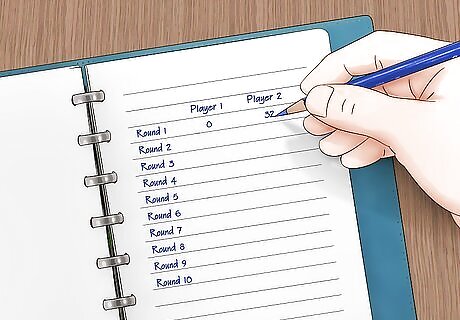
Continue playing and keeping score until all the double tiles are used. Each new round is started with the engine tile that is one number lower than the one used in the previous hand (double-9 for the first hand, double-8 for the second hand, double-7 for the third, and so on). The blank double is the last engine you will use before the end of the game (blank tiles can only be matched with tiles that also have a blank side). The already-used double tiles just get mixed back in with the other tiles when you shuffle between rounds.


















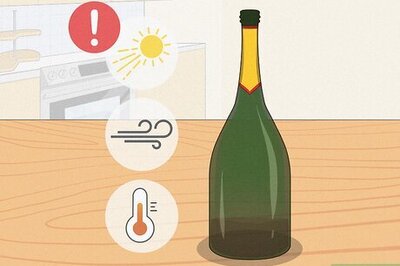
Comments
0 comment